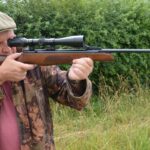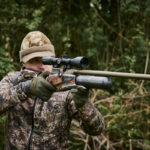
Winchester’s Model 1873 lever action was the first truly successful high-capacity repeating rifle. Bugs that plagued the ancestral Henry Model 1860 and Winchester Model 1866 were largely eliminated in its design, and it quickly became the favorite of ranchers, cowboys, lawmen, and outlaws. During the half-century it was manufactured, just over 720,000 were produced.
Manufactured in 1889, the Model 1873 shown and reviewed here represents the most popular configuration—the “rifle” model with crescent buttplate and 24-inch octagonal barrel. Second in popularity was a carbine version with a 20-inch round barrel. There was a third standard type (“musket”) with a 30-inch barrel and full-length stock, but it made up only about five percent of total Model 1873 sales. In addition, many custom 1873s were built and shipped.
Chambered in various cartridges, ranging from .25-20 Winchester through .44-40 Winchester, the Model 1873 was really a pistol-caliber rifle. It did not compete with the big-bore single-shot rifles and lever actions favored by big-game hunters in the Rockies and on the buffalo ranges. High cartridge capacity, light recoil, and good-enough ballistic performance for use out to 100 yards or a bit more were the Model 1873’s forte.
Table of Contents
Mechanicals
The Winchester 1873 loads through a gate in the right side panel of the action. Rounds are contained in a tubular magazine beneath the barrel and fed up into the chamber via a lifting-block arrangement that serves triple-duty as a magazine cutoff and as a moving, mechanical ejector. The slender bolt reciprocates rearward inside the top of the action, and its rearmost portion pushes the hammer back to fullcock when the lever is opened.
When the lever is worked, a simple hook-type extractor positioned at 12 o’clock in the boltface draws the empty cartridge case from the chamber. The bolt cocks the hammer, and the lifter brings a fresh cartridge into alignment with the chamber, boosting the empty cartridge above up and out of the ejection port. Bringing the lever briskly back into firing position runs the bolt forward, pushing the fresh cartridge into the chamber.
A trigger-cutoff-type safety is incorporated in the action, and the lever must be squeezed fully closed before the trigger can be pressed. To prevent the lever from inadvertently opening while in the field, a rotating catch is provided at the rear of the lever and may be rotated to secure it in the closed position. Another field-expedient feature is the sliding dust cover atop the action, which may be manually closed to prevent grit from accumulating inside the action.
An additional safety is present in the form of a halfcock notch in the hammer, which may be lowered to this position after chambering a round.
Provenance
The .44-40 rifle reviewed here belongs to a good buddy of mine. His father purchased it for $700 and then handed it down to my friend. The original owner had it most of his life and had hunted with it. A close look inside the bore showed quite a lot of pitting and rounded-off rifling. A gentle but thorough cleaning removed accumulated dust and remnant traces of fouling.
Rangetime
Out of deference to the rifle’s vintage, I assembled two mild handloads to test-fire through it. One consisted of a 200-grain hard-cast bullet sized to 0.429 inch, with the correct nose shape and length for the .44-40, over 7.3 grains of Unique powder. The second load featured a 180-grain short-jacketed hollowpoint bullet over 6.0 grains of Trail Boss powder. Both loads were primed with Winchester Large Pistol primers in Winchester brass.
Not knowing how the worn bore would shoot, I placed my test target at 25 yards. I tested the jacketed-bullet load first, thinking that the cast-bullet loads might quickly build up leading in the pitted bore.
The mild jacketed-bullet load averaged 0.93 inch, and initially the load with the hard-cast 200-grain bullets showed tremendous promise. The first group clumped into one ragged 0.64-inch hole; however, as I expected, the more I shot the cast bullets, the worse accuracy became. Still, they averaged an acceptable 2.13 inches.
With accuracy testing wrapped up, I stepped away from the bench and shot casually, running a few rapid-fire rounds at my steel Birchwood Casey popper target. While I didn’t get too aggressive about speed, the vintage rifle ran smoothly and without a hitch—and without a miss. Balance was wonderful, and recoil was mild. It’s no wonder it was the most popular all-around rifle of its time.











































